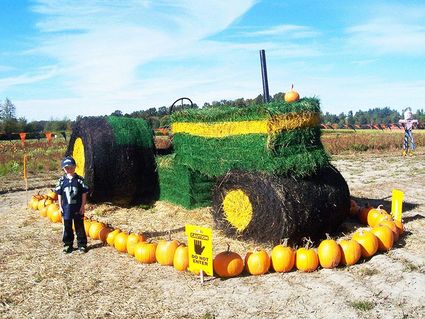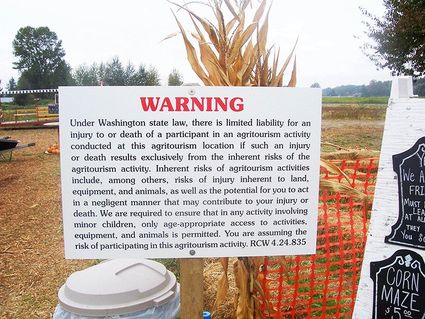Reflections on another October in the agritourism sector
December 6, 2017
Reporter's note: My wife and I just returned from western Washington where we spent the month of October working at Biringer's Black Crow Pumpkins and Corn Maze outside Arlington (50 miles north of Seattle). This pumpkin patch and maze was started six years ago by Gary and Julie Biringer. Gary is the third generation Biringer farmer to be in what is popularly now called agritourism-"...any agriculturally based operation that brings visitors to a farm or ranch." Agritourism is also known by other names: agritainment; value added ag products; farm direct marketing and sustainable agriculture.
Living in a rural area where so many folks make their living on farms and ranches we may not recognize the 'tourism' side of agriculture. Agritourism can include buying products direct from a farm stand, navigating a corn maze, picking fruit, feeding animals or staying at a dude ranch or bed and breakfast on a farm. There are examples of all these activities of agritourism in Montana, many in our own area, like the roadside summer vegetable and fruit stands. Tourism in Montana contributes $6 billion to the state's economy and agritourism is expected to account for a growing part of those tourist dollars.
I thought it might interest readers to know something of how agritourism works in other areas. My only real experience is working on the Biringer's Berry Farm and for the last few years, at the pumpkin patch. Here's some of what I've observed about agritourism while at the pumpkin patch.
Developing a niche
and a unique hook
Biringer's Black Crow Pumpkins and Corn Maze is in north Snohomish County-with an area that includes part of the Cascades, some densely populated suburbia and open farm and wildlands . Biringer's pumpkin patch is just off I-5, literally at an interchange, and about 50 miles from downtown Seattle. While there is farmland all around the area, the urban sprawl is gaining traction in the area. The pumpkin patch is on a busy highway that accesses the interstate from Arlington and the traffic gets noticeably worse each October we return. Silage trucks, tractors and commuters battle to and from work during October.
Pumpkin patches and corn mazes are very popular in Snohomish County. A website that helps Seattle-area folks find a pumpkin patch lists 70+ and likely many small ones that aren't listed. Some of the patches, particularly in the south part of the county and closer to large population centers, are what I would describe as "circus-like" as they feature elaborate 'scary' corn mazes (where costumed characters jump out at you and some where you can shoot at the scary characters with paintball guns), 'haunted barns,' petting zoos and large snack bars and gift shops. They attract school kids by the bus loads on school days. The farms often create their own traffic gridlock on surrounding roads and streets.
Julie and Gary Biringer are pet owners, or "pet parents." They decided to make their pumpkin patch and corn maze less of a carnival, more family oriented and "pet friendly." Dogs are welcome if on a leash and owners 'scoop the poop.' There are literally thousands of dog owners in the Seattle area and owners are often looking for new places they can take their dogs. Over the five years I've been involved at the patch, I've seen the numbers of customers bringing dogs grow exponentially.
While some pumpkin patches say they are dog friendly, checking out the fine print you will find "only in designated places" like the parking lot. Of the 70+ patches listed, only three allowed dogs every place on the farm. Biringer's allows dogs in all areas and is the closest patch to Seattle.
A customer who owns a dog sitting business told me, "I'm in a growth sector. There are many more dogs than kids in Seattle proper." Dog owners, many of whom are in clubs for the breed of dog they have, share social media posts when they find a dog-friendly place. Several breed clubs have scheduled outings at the Biringer patch that bring people together, with their dogs, from all over the area. One customer told of learning about the dog friendly pumpkin patch when he saw a flyer at a dog park in metro Seattle. Dog owners talk to each other and they share a lot of information via various social media outlets. (The Black Crow patch has its own Facebook page and uses several other social media resources to announce special events or deals).
Special deals brings me to the 'unique hook' idea employed by Biringers. The customers go out into the patch and get the pumpkins they want. The pumpkins are priced by size, this year ranging from $2 for the kiddie size to $25 for the big lunkers. Customers push wheelbarrows out to the field, load up, bring their produce to the stand to pay, then load their pumpkins in to their vehicles.
I'm not sure how this exactly got started but about three years ago Gary Biringer got the idea of selling pumpkins, gourds and squash 'by the wheelbarrow load' from the field. Instead of pricing each individual item a customer selects there is a set price for a wheelbarrow full of any produce from the field. It actually is a good deal because if a customer buys two large pumpkins they are very near the price of a full wheelbarrow and the additional decorative gourds, edible squash and more pumpkins are a 'gimme.'
Biringers soon discovered a big selling point was for people to compete and show just "how much we can stack in a wheelbarrow." The only rule is one person pushing the wheelbarrow and no one steadying the load. After three years we have couples and families showing up just to see how big a load they can create. They tell us they split the produce when they get home.
Some other concerns
related to agritourism
Farmers and ranchers are continually reminded that theirs is a dangerous line of work, with some studies showing farming the deadliest occupation during the past decade. What happens when you let people who've never been around farm animals or equipment on to a farm property? Despite an operator's best efforts, accidents can happen on a farm operation.
Recognizing that liability issues dampen agritourism, several states have passed legislation that gives farm operators some protection. This year both Washington and Montana passed laws that acknowledge there is inherent risk visiting an ag operation and that an accident does not necessarily mean someone was negligent. This legislation gives agritourism operators some peace of mind.
And how people pay for things has raised some technological challenges on the farm. Hardly anyone, especially under thirty years of age, carries cash. They come to the pumpkin patch and buy a $1 bottle of water with a credit or debit card. New cashiering programs and equipment, like 'the square' (a device that allows a card to be swiped through a smart phone) has changed how farmers can sell, even at roadside stands.
Corn mazes, those complicated paths cut through standing fields of corn, used to take days to measure and cut or required a farmer to spend a lot of money to have a professional maze cutter create a maze. My boss takes a line drawing and, using a farm program, loads the drawing in to a GPS on his tractor. He said, "I follow the red dot and cut the maze. If the corn is really mature I never see where I am until the maze is cut and I leave the field." He used to hire a pilot at the local airport to fly over the maze and take a photo so customers could see what they were entering. Now a retired guy comes, with a drone, and does the same work for a few free pumpkins.
Agritourism for Biringer's Black Crow Pumpkins and Corn Maze is more than just selling pumpkins. Charles Revson, who created and ran Revlon cosmetics for five decades, once said, "In the factory we make cosmetics; in the store we sell hope." To paraphrase Revson, "At Black Crow Pumpkins and Corn Maze we raise pumpkins; in October we sell fun and quality family time." The agritourism sector is definitely growing.




